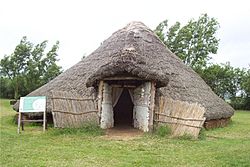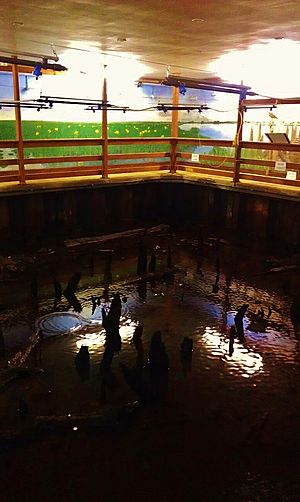Flag Fen facts for kids
Flag Fen is an amazing ancient site located east of Peterborough, England. It was built about 3,500 years ago during the Bronze Age. Imagine a huge wooden walkway, almost 1 kilometer (0.6 miles) long, made from over 60,000 timbers! This walkway stretched across a very wet area called the fenland.
Part of this wooden structure formed a small island. Experts believe this island was very important for religious reasons. Archaeologists started digging here in 1982. Today, Flag Fen has a visitor center and some reconstructed buildings, like an Iron Age roundhouse. You can even see a part of the original wooden walkway preserved in a special hall.
Contents
Building Flag Fen
Long ago, during the Neolithic period, there was an old path across what is now Flag Fen. This path connected a dry area called Fengate to a natural clay island named Northey. The area around Flag Fen was low and often flooded.
Around 1300 BC, the water levels rose even more. So, the people living there decided to build a strong wooden walkway along the old path. They pushed thousands of posts with sharp tips deep into the muddy ground until they hit firmer soil. This huge structure covered about 3.5 acres (1.4 hectares).
Scientists used a method called dendrochronology to date the wooden posts. This means they studied the tree rings to figure out when the trees were cut. They found that the different parts of Flag Fen were built between 1365 and 967 BC. Some of the wood, like oak, was not from the local area. This shows that people worked very hard to bring these heavy timbers from far away places.
Why Was Flag Fen Built?
Archaeologists found many valuable items in the water around Flag Fen. These included swords, spearheads, gold earrings, tiny pins, and brooches. These items showed that the people who owned them were important or wealthy.
Francis Pryor, the archaeologist who discovered Flag Fen in 1982, thinks that people might have thrown these valuable things into the water to show off their status. They wanted to prove they could afford to get rid of expensive items. Some items, like daggers, were even broken in half before they were placed in the water.
Other interesting finds included small, smooth, white stones. These stones were not from the local area, meaning someone brought them to Flag Fen on purpose. Animal bones were also found, including horse jaws. Horses were very important to people back then. They helped with travel and could pull heavy loads, like timbers on sledges.
The way these items were placed, always within 30 meters of the wooden posts and only on the south side, is very important. People continued to place these items for over 1,200 years. This suggests that Flag Fen was likely a special place for religious ceremonies.
On Northey Island, many ancient burial mounds called round barrows were found. These mounds were built around the same time as Flag Fen. It seems that important leaders or "chiefs" were buried under these mounds. Some experts call this area the "Land of the Dead." There is also evidence that people farmed here, with remains of sheep found. It seems that people who respected these leaders might have paid to be buried near them.
How Flag Fen Was Preserved
The Flag Fen area was very wet, which helped peat (a type of soil made from decaying plants) to form around 2000 BC. This peat is still there today. The wet, muddy conditions meant that there was no air (anaerobic conditions). This stopped the wooden posts and other parts of the structures from rotting away.
Over time, the ground level slowly rose as more plant material was added to the fen surface. By the time of the early Roman period, most of the wooden structure was covered and safely preserved underground.
Exploring Flag Fen: Archaeology
Flag Fen was discovered in 1982 by a team led by archaeologist Francis Pryor. They were surveying ditches in the area. Pryor once said he "stumbled – literally – upon" Flag Fen when he tripped on a piece of wood in a ditch!
Excavations began in 1984. By 1990, they had found many things: vertical and horizontal timbers, animal bones, a bronze dagger, other metal pieces, flint tools, and hundreds of pottery fragments. They even found items from other parts of Europe and the oldest wooden wheel ever found in England!
In 2012, a group called DigVentures did something new: they raised money from the public (called crowdfunding) for a three-week excavation at Flag Fen. This helped bring more visitors to the site. About 250 people from 11 countries got to help with the digging and learn archaeological skills. Visitor numbers went up by 29% that year! Francis Pryor was very happy with this project, saying it was a successful experiment.
Keeping Flag Fen Safe
Archaeological work is still happening at Flag Fen. However, draining the surrounding land for farming means that some of the ancient timbers are drying out. When wood dries out, it can be damaged.
To protect the wood, one section of poles is being preserved using a special technique. Water-carried wax is slowly put into the wood over many years, replacing the wood's natural material. This method is also used for other important ancient wooden sites like Seahenge. Another way they preserve timbers found at the site is by freeze drying them.
The Flag Fen Bronze and Iron Age Centre has a great visitor center with a museum and exhibitions. In the preservation hall, you can see a section of the original timbers. They are kept from drying out by a mist of water.
At the site, you can also see reconstructed roundhouses from the Bronze Age and Iron Age. A part of the ancient Roman road called the Fen Causeway is also visible. Plus, there's a reconstructed prehistoric droveway, which was a path used for moving livestock like cattle.
Books About Flag Fen
Francis Pryor has written several books about Flag Fen. His first book, Flag Fen: Prehistoric Fenland Centre, came out in 1991. A bigger report, The Flag Fen Basin: Archaeology and environment of a Fenland Landscape, was published in 2001. He also wrote Flag Fen: Life and Death of a Prehistoric Landscape in 2005, which updated some of his earlier ideas.
Must Farm
About 2 kilometers (1.2 miles) south of Flag Fen is another Bronze Age settlement called Must Farm. Ancient log boats found there are now preserved and displayed at Flag Fen.
Wildlife at Flag Fen
Flag Fen is also a wonderful place for wildlife! It has many different habitats, like large grasslands, traditional hedgerows, woodlands, and a freshwater lake and ditches.
'Bronze Age' BioBlitz
On August 2, 2014, a special event called a BioBlitz took place at Flag Fen. Experts and volunteers found 190 different species of plants and animals! This included 53 types of lichens and endangered animals like the European water vole and barn owl. The event also highlighted animals that would have lived there 3,000 years ago, such as the grey wolf, brown bear, and Eurasian beaver.
Meadow Plans
In 2014, a group called Buglife started a project to create wild-flower meadows across Peterborough. This included making a traditional hay meadow at Flag Fen, which helps local wildlife.
Gallery
See also











